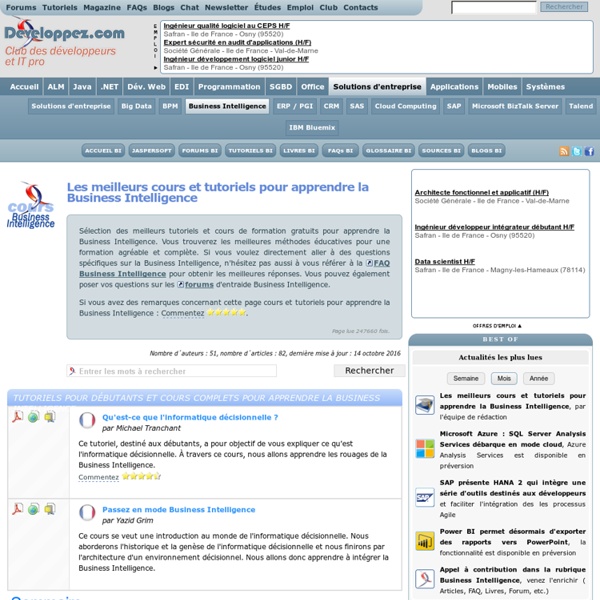



Conception d'un entrepôt de données Nous avons vu dans mes articles précédents ce qu'était le BI, ce que comprenait un environnement décisionnel et qu'il avait comme concept central l'entrepôt de données ou le Data Warehouse. Intéressons nous maintenant à comment concevoir un entrepôt de données. Quelle structure permet-elle d'avoir les fonctionnalités requises pour un entrepôt de données ? Quelles sont les techniques utilisées pour bien concevoir ? Quels sont les indicateurs d'une bonne conception ? Ce mini cours commencera par introduire (ou réintroduire) les concepts fondamentaux de l'informatique décisionnelle (nécessaires pour la compréhension de cet article), continuera par l'explication des méthodes de conception d'entrepôt de données via une étude de cas, et terminera par une critique de ces techniques et une conclusion mentionnant les indicateurs d'une bonne conception d'entrepôt. II-A. J'estime en avoir assez parlé ici et ici : mais un peu de répétition ne fait pas de mal !!! II-B. II-C. II-D. II-E. II-F. II-G.
What is BI? Introduction Before diving into an explanation of dashboards, it is important to have a fundamental understanding of business intelligence (BI). To be sure, there are many definitions, but Dashboard Insight defines it as: Turning data into knowledge to support informed decision making. Successful BI implementations require technology to store, analyze, and present data; furthermore, it requires a certain way of thinking: the BI Philosophy. BI Technologies The following image illustrates the BI Technology Stack and depicts the relevant technologies typically needed to implement BI in an organization. The data layer consists of technologies that organizations use to store their raw data (web statistics, sales transactions, etc.). The analytics layer draws from the data layer. The presentation layer delivers the processed data in a meaningful and intuitive way to data analysts, business analysts, and individuals at all levels within an organization. The BI Philosophy Conclusion
Microsoft BI Books « Data Warehousing and Business Intelligence Microsoft BI Books Analysis Services (SSAS) Books, including Data Mining, MDX & OLAP Integration Services (SSIS) Books including ETL Reporting Services (SSRS) Books Microsoft BI Books (mix of SSIS, SSAS, SSRS) If you think a book should be here, or if you want other information to be included, please let me know (vrainardi@gmail.com or via comments). Like this: Like Loading... Gartner - Magic Quadrants Positioning Technology Players Within a Specific MarketWhich are the competing players in the major technology markets? How are they positioned to help you over the long haul? A Gartner Magic Quadrant is a culmination of research in a specific market, giving you a wide-angle view of the relative positions of the market's competitors. By applying a graphical treatment and a uniform set of evaluation criteria, a Magic Quadrant helps you quickly ascertain how well technology providers are executing their stated visions and how well they are performing against Gartner's market view. View all Magic Quadrants Challengers Execute well today or may dominate a large segment, but do not demonstrate an understanding of market direction. Leaders Execute well against their current vision and are well positioned for tomorrow. Visionaries Understand where the market is going or have a vision for changing market rules, but do not yet execute well. Niche Players How do I use a Gartner Magic Quadrant?
Supports de cours -- Data Mining Cette page recense les supports utilisés pour mes enseignements de Machine Learning, Data Mining et de Data Science au sein du Département Informatique et Statistique (DIS) de l'Université Lyon 2, principalement en Master 2 Statistique et Informatique pour la Science des donnéEs (SISE), formation en data science, dans le cadre du traitement statistique des données et de la valorisation des big data. Je suis très attentif à la synergie forte entre l'informatique et les statistiques dans ce diplôme, ce sont là les piliers essentiels du métier de data scientist. Attention, pour la majorité, il s'agit de « slides » imprimés en PDF, donc très peu formalisés, ils mettent avant tout l'accent sur le fil directeur du domaine étudié et recensent les points importants. Cette page est bien entendu ouverte à tous les statisticiens, data miner et data scientist, étudiants ou pas, de l'Université Lyon 2 ou d'ailleurs. Nous vous remercions par avance. Ricco Rakotomalala – Université Lyon 2